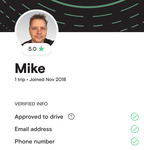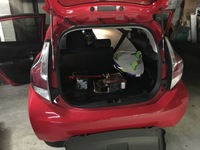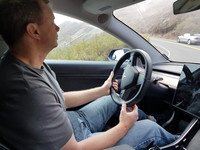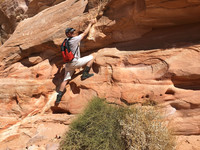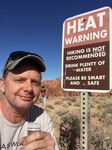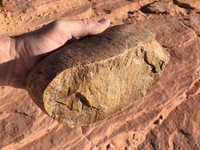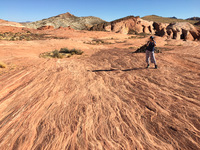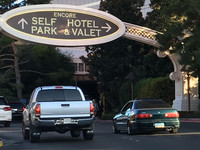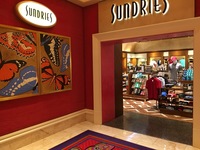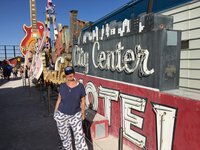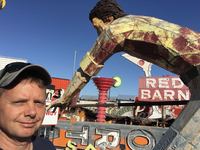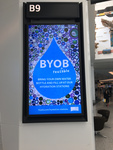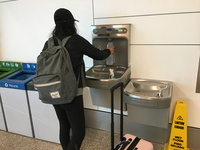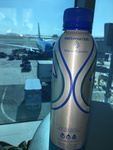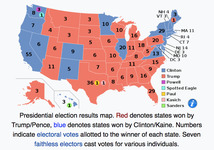 |
| Angelika/Mike Schilli |
|
|
Michael On vacation, we regularly drive around in rental cars in foreign cities. Typically, you book a "category" and not a specific car type. Once, at Sixt in Munich, I booked the "VW Golf GTI" class, but at the counter, they tried to give me an Opel Mandriva, a minivan for soccer moms. In Las Vegas, I once booked a Prius, but when I showed up, there was no Prius available. I made a fuss and was eventually appeased with a Japanese sports car, an Infiniti G37S. But I've always wanted to drive a Prius, the legendary hybrid car that Americans have been using to save gas for about 20 years, because the small gasoline engine keeps charging a large battery that then powers the car without gasoline during calm driving phases. While our Honda Fit guzzles a good eight liters per 100 km (30 miles/gal), a Prius manages with just four (60 miles/gal). I know, I know, in Germany people drive around in Matchbox cars that also only consume four liters (60 miles/gal), but in America, you can't get by with less than 100 horsepower.
Recently, the company Turo set out to break through the jungle of regulations and insurance for commercial car rentals (similar to how AirBnB did for hotels and Uber for taxis) and to act as an agency through which private individuals can rent out their cars to other private individuals. According to my research, the company already exists in Germany as well! Using a smartphone app, you can choose from a wide range of cars, plan a "trip," and then the renter ("Guest") meets with the owner ("Host") at the agreed upon pickup time for the key handover, and off you go. The app is used to take photos of the car at both pickup and return to ensure that the renter hasn't caused any new damage. Finally, both the renter and the owner rate each other with up to five stars so that future Turo customers know what kind of person they're dealing with.
Newer Prius models were available in San Francisco on Turo for about $60 per day, and I chose a rental with comprehensive insurance with a high deductible ($3000), which cost an additional $15 per day. Overall, a worthwhile fun for the weekend. For luxury cars, however, you pay a bit more, for example, around $150 for a Tesla Model S. But well, that's obviously much cheaper than the purchase price of $80,000. Since private cars mostly just stand around doing nothing, the business is equally rewarding for both renters and owners. The owner gets a part of their immense acquisition and maintenance costs reimbursed, and the renter has the opportunity to drive the car of their dreams, even if it's just for a day, saving themselves from buying a vehicle that quickly depreciates in value.
Pickup and return went smoothly in our self-test. The rental provider turned out to be an exceptionally nice person from a neighboring district, who even took the time to explain the various energy-saving modes of the vehicle to me and to give some good driving tips. It was fun to use the little car to complete our usual weekend routines: grocery shopping, going to Ikea, to the football field, and so on. The Prius C, the short version of the original model, is of course not a sports car, but you get used to it. After a while, driving becomes much more relaxed, and you automatically try to limit acceleration so that the display stays in Eco mode and the gasoline engine remains off -— well, maybe that's one reason why Prius drivers are notorious for being slowpokes. I even tested whether my large, 8 foot long surfboard would fit inside (check!) and a new desk chair bought at Ikea could be effortlessly inserted through the tailgate onto the enlarged loading area by folding down the seats. A well-constructed car, I must say.
How is the rental car insured with Turo now? As always, it's important to look closely at the fine print and to understand the difference between liability insurance and comprehensive/collision insurance. In America, liability insurance usually stays with the car, so if, for example, we lend our car to a friend and they have an accident, our liability insurance covers the third-party damage -— though our premiums would likely skyrocket afterwards. If a private individual rents out their car on Turo, their liability insurance generally puts a stop to it, as commercial car rental is usually explicitly excluded in the contract. However, Turo has taken precautions and arranged a group insurance policy with a major American insurer (Liberty Mutual), which provides liability coverage of one million dollars for each car rented through Turo.
Interestingly, Turo also offers renters various insurance packages that primarily regulate the deductible for comprehensive insurance but allegedly also affect liability, which varies depending on the package between one million dollars and the much lower state-mandated minimum (in California, for example, only $15,000 per person for personal injury, $30,000 per accident, and $5,000 for property damage). The whole thing smells like total insurance chaos because, in the event of an accident, up to four different insurers could be involved: the liability insurance of the owner, Turo's group insurance, the renter's liability insurance (if they have one for their private car that also covers rental cars), and the comprehensive insurance package the renter may have purchased from Turo. In the event of an accident, the renter can undoubtedly expect a few rounds of rigamarole on the phone. On the other hand, the comprehensive insurance, which covers damages to the rental car, costs between 18% and 80% of the rental price, depending on the deductible. At 18%, the renter has to pay $3,000 out of pocket for car damage before the insurance kicks in. At 80%, the insurance covers everything, but this option is only available for vehicles that cost less than $35,000.
We were very satisfied with our rental; even driving in traffic jams is fun with the Prius because it automatically decelerates slightly and charges the battery with the energy gained when you simply take your foot off the gas pedal, without having to constantly step on the brake when the car in front is driving erratically. However, the colorful graphic display on the dashboard probably leads Prius drivers to accelerate very slowly to keep the Eco-Meter in the green zone -- which likely contributes to the aforementioned slowpoke image. But if you step on it properly, it does have some power; after all, 99 horsepower is nothing to sneeze at.
For our second Turo trip, I booked a Tesla Model 3. With the 100 miles included in the price, I planned a route heading north over the Golden Gate Bridge, then down the winding mountain road to Muir Beach, where we did a short hike. Then we went up to Point Reyes Station for lunch, over to Nicasio to our favorite cheese factory, and back over the bridge into the city. That was 90 miles, and the Tesla's battery indicator went from 66% to 30%. The little car has "only" 270 horsepower, but it accelerates completely linearly and so strongly that you feel pressed against the seat like on a roller coaster. I left a series of German luxury sports cars in the dust.
Before driving a Tesla, you should definitely watch a few explanatory videos. An average person might not even be able to open the driver's door with its quirky door handle. Once in the driver's seat, you look for the gear lever and find out that Tesla has repurposed the windshield wiper lever to the right of the steering wheel as the gear lever: pull up to go in reverse, push down to go forward. You turn on the windshield wipers on the tablet in the center console by swiping and tapping through menus. You press the gear lever down twice to activate the autopilot, which maintains the distance to the car in front and keeps the lane on the freeway. This function even initiates overtaking on its own when you activate the turn signal, but I found that too risky to try out in traffic. Before returning the vehicle, the owner wanted me to take the Tesla through an automatic car wash, and when I got there, I suddenly remembered that you have to put it in "N" for Neutral (i.e., neutral gear), but how do you do that with a lever that only has "R" for Reverse and "D" for Drive? Luckily, I saw a car wash attendant in front of the already dangerously rotating brush, and I rolled down the window and quickly asked how to put a Tesla in "N." He was familiar with the problem and simply reached in, pulled the lever just a bit, not all the way down, and waited two seconds until the tablet displayed "N." You have to figure that out first!
Angelika Since we have been living in the US, I have grown very fond of the so-called "State Parks." Many are as spectacular as the famous National Parks, but often not as crowded and more manageable. In the US, National Parks are managed by federal authorities, while the "State Parks" are under the supervision of the respective state. California alone has 280 State Parks and was one of the states that early on promoted nature conservation with the help of the State Park system. The California Gold Rush, during which many landscapes were ruthlessly defaced and exploited to mine gold, led to land in Yosemite Valley being placed under protection as early as 1864, with the goal of preserving the land and making it available to the public for recreational purposes.
Now there are not only "State Parks" in California, but also in Nevada. And when we were in Las Vegas again recently, we took a day trip to the "Valley of Fire," the oldest and largest state park in Nevada. We had already visited this park in 2003 and had long planned to visit it again for some hiking. Since the park is only 50 miles northeast of Las Vegas and this time we were touring in the not-so-scorching month of October, we left the Strip with its casinos behind for a day and drove into nature with our rental car. In summer, it is not advisable to hike in the park because the average temperatures are at least 100 degrees Fahrenheit, but they can also climb to a scorching 120 degrees.
Whoever hikes must be well-nourished, so we got ourselves a hearty sandwich in the little town of Overton, which is just around the corner from the "Valley of Fire." We got it from a shop with the lovely name "The Inside Scoop." The "Scoop" refers to an ice cream scoop, as the establishment offered not only savory sandwiches but also homemade ice cream. My sandwich was so thickly filled that I could barely fit it in my mouth later, an unmistakable sign that we were in the middle of nowhere, where food portions seem to grow in proportion to the non-existent population density.
In the park, we first paid the entrance fee of 10 dollars per car through a self-payment system. At the park entrance, visitors grab a small envelope provided by the park authority from a brown mailbox-like device. Then, they usually write their name, car license plate number, and the date of the visit on the front of the envelope (hoping that the provided pen works), put 10 dollars in the envelope (yes, sometimes you still need exact cash even in the US), seal the envelope, and tear off the small control slip from the envelope, which is then placed visibly on the car's dashboard after the money-filled envelope is deposited in the slot of the mailbox-like device. After this bureaucratic act, we needed to some nourishment and found a cozy spot at a picnic table under a huge rock that provided nice shade in the dry desert landscape. We ate our sandwiches, which immediately attracted dozens of small ground squirrels from their holes, hoping for crumbs and other treats.
In the park, we then took two beautiful hikes: "White Domes" and "Fire Wave," to enjoy the park's beauties. The Valley of Fire is characterized by stunning red sandstone formations. These were formed 150 million years ago through the complex movements of large sand dunes. Although there were actually quite a few visitors in the park, we again experienced that we were quickly almost alone on the hiking trails, as many of the tourists just got out of their cars, quickly took a few photos with their phones, and then drove off again. The real beauty of hiking the trails is discovering new unique sandstone formations that change color with the varying positions of the sun. What fascinates me the most is the silence in the desert, as it is neither quiet nor calm in San Francisco nor at my job in the school. The second hike led us through the desert landscape to a huge rock formation that looked like a large, rippling wave. It was as if water had turned into stone with reddish, brown, and beige color shades. Uniquely beautiful!
Michael Las Vegas is a must-see for German tourists, but for us, it is a special place because we met in Las Vegas for the first time, ages ago. We go there from time to time to refresh our memories and to see what has changed in this city of madness since our last visit. And there is always something going on.
And of course, Las Vegas is a tourist trap like no other, but our trick is to move like locals. This starts right after landing at the airport, when tourists stand in line for hours at the Alamo or Budget counters to get a rental car, while we simply jump into our Hertz car and drive off. Then, we don't head straight to the booked hotel on the Strip, but instead go directly to a large supermarket where we buy bottled mineral water and other drinks in bulk. Casino hotels only sell drinks in the minibar or small shops at exorbitant prices; you can't get bottled water there for less than five or six dollars. Leaving the casino is extremely annoying, as you have to walk miles to the nearest store.
When parking the rental car, we prefer so-called self-parking in hotel garages like those at the Encore or Vdara. Valet parking, where a hotel attendant parks the car, is a completely idiotic concept, even if the hotel offers it for free. When you need the car again, you end up standing around dumbly at the entrance until the attendant finally retrieves the rental car from the garage, and you have to tip him for it! We simply roll our rolling luggage from the self-parking garage to the hotel reception, check in, and that's it. When we need the car, we just get in and drive off. By the way, if you're only staying within city limits, there's no need to book a rental car at all; you're better off using Uber and Lyft. But we like to drive around in nearby areas.
When dining out, the rule is: People who have traveled from all over America don't care at all about the cost, because those who only have a diner at home, where people sit with baseball caps on, are happy to spend a construction worker's weekly wage on a rather mediocre dinner, as long as it's served on expensive linen and bustling waiters are hovering between the tables. Restaurants in casinos on the Strip are generally about twice as expensive as in a city with a wide selection of restaurants. Those looking for a better price/performance ratio are better off in one of the trendy restaurants west of the Strip, although the more established places there are also charging quite hefty prices nowadays.
When it comes to hotel prices, it should be noted that practically all major hotels on the Strip add an absurd rip-off fee of about $45 per day, which they call "Resort Fee" (Rundbrief 10/2016). No upright person can justify it without bursting into laughter. Classic rip-off, you just have to add it to the room price. It's astonishing that this criminal behavior hasn't been prosecuted yet, but maybe in ten years there will be a class action lawsuit, and all those who were ripped off will get their money back from the casino criminals, one can only hope. It's also important to note that the nights from Friday/Saturday and Saturday/Sunday are about twice as expensive as all the others. So, if you can postpone your visit by a day, you might save some real money.
It should be noted, however, that the casino tricksters are very cunning and always come up with new ways to take people's hard-earned money. On the next visit, everything will definitely be even more expensive again!
Michael Gambling in the casino is the main attraction for many visitors in Las Vegas. Some save up all year just to let loose at the blackjack or craps table for a few hours -— and then go home without any money left. We also like to spend some time in the casino, but not just because of the slot machines; it's because human dramas unfold there that can only happen at a casino. During our last visit, we overheard a couple where the woman confessed to the man that she felt guilty about blowing her grandmother's gift money and wondered if she should rather invest it in a tank of gas for the car. No, no, the man said, after all, it was her money now and she could spend it however she wanted!
We are not big gamblers, but we are fascinated by the somewhat outdated video poker machines. We play by some simple rules that allow us to get back 99% of our stake, and while we play, the casino waitresses serve us high-quality alcoholic drinks for free, for which we only tip the waitress about one to two dollars each time.
I have already described the video poker strategy before (Rundbrief 03/2009), so just a brief recap: The goal is to keep the right cards from the five initially dealt cards and exchange the rest once, in order to form a good poker hand: a high pair, a full house, a straight, or even a royal flush. Depending on the value of the hand, the machine then pays out the winnings or remains silent. Using probability calculations, one can determine which cards to keep from a given hand for the highest possible chance of winning and which to exchange. For each situation, mathematics prescribes the "correct" move, but keeping all the individual rules in mind is not quite simple.
But with some practice, you can achieve about a 99% payout rate; really savvy pros can even reach 99.5% -- so the casino always wins 50 cents for every hundred dollars wagered, which is more than worth the alcohol-fueled fun. If you want to test at home whether you have mastered the rules, I recommend the smartphone app "Winpoker," which not only accurately simulates the slot game but also issues warnings if the player should have chosen different cards than the ones clicked. The app even calculates how much each playing error costs, down to the last cent, and mathematically inclined individuals can compare the winning probabilities of different moves. That brings out the inner child in every man.
Angelika When it comes to Las Vegas, we understandably get sentimental. Sometimes we really miss the old Las Vegas. After all, back then we used to go there as students to eat cheaply and abundantly at the "All You Can Eat" buffets, to snag an affordable rental car, and then to dash off to the various national parks. Las Vegas has reinvented itself many times since our first encounter there, but for us, the city is enveloped in nostalgia because that's where we met. We never tire of seeking that feeling during our visits.
At the "Neon Museum," we got our money's worth this time. Anyone who has ever been to Las Vegas knows that colorful, oversized neon signs follow you at every turn, sparkling and blinking. In Las Vegas, the lights seem to never go out. Many of these neon signs have achieved a certain iconic status, either because they have a particularly beautiful or controversial design, or because they belonged to a casino that no longer exists but once held an important place in the history of Las Vegas.
The Neon Museum was founded in 1996 for the purpose of preserving these old signs and making them accessible to the public. The open-air exhibit displays them outside in the so-called "Boneyard," and visitors walk through the laid-out paths and can admire the neon signs set up at ground level. The sun beats down mercilessly from the sky, as Las Vegas is known to be in the desert, and there is no shade in the open-air settings. We arrived at the museum in the late afternoon because the sun then made the neon signs appear in a particularly beautiful light.
The idea for the museum came about when the famous casino and hotel "The Sands" closed in 1996, and no one knew what to do with the historic and oversized "Sands" sign. Unfortunately, it ended up in the trash. The friendly museum staff explained to us that the size of the signs often poses a problem, as dismantling and transportation are costly.
The "Young Electric Sign Company" (YESCO), based in Salt Lake City, Utah, was the original manufacturer of many of these signs and is still considered a leader in the industry today. The Neon Museum now houses many well-known signs, such as those from the casinos "Stardust," "Aladdin," "Riviera," and "Sahara." However, I particularly liked the lesser-known ones, such as a little milkman figure delivering milk. The museum charges $30 per person for admission. You are only allowed to take photos with your phone or tablet. Despite the high admission price, we highly recommend a visit to the museum.
Michael Air travelers often get so thirsty on long-haul flights that flight attendants can hardly keep up with refilling drinks. Therefore, it is advisable to carry bottled water. But, oh dear, unfortunately, airport security does not allow liquids to be brought through, so it has become customary for travelers to quickly purchase a plastic bottle of water at the gate area at an exorbitant price. Did I say plastic?! For heaven's sake, plastic waste is no longer acceptable in green San Francisco!
Drinking American chlorinated tap water is also not everyone's cup of tea, and that's why the operators of the newly redesigned Terminal 1 at SFO Airport, which has recently been named "Harvey Milk Terminal" after the well-known gay activist from the 70s (Rundbrief 07/2006), installed so-called "hydration stations", where passengers can fill their own containers with Brita-filtered tap water. To prevent anyone from placing the rim of their bottle, which might be contaminated with germs, directly on the spout, the stations activate the water stream using a light sensor when a container is held under an upward-facing hole in the chrome frame of the station.
Anyone who has forgotten to bring their own bottle can purchase pre-filled reusable bottles with water at the kiosk for four or five dollars, available in two different sizes. By the way, the filling machine looked strangely familiar to me: in our fitness center at Apple, where no plastic bottles are distributed anymore, there is exactly the same unit from the company "Elkay." With this, San Francisco officially enters the heavenly realm of environmental angels.
Angelika In the last newsletter, I promised to explain why we have great concerns that Trump might get re-elected. As I said, I would be very happy if my prediction turns out to be wrong. But why do I hold this opinion? It is true that a lot can happen before the actual election date in November 2020, but anyone who thinks that Trump will be removed from office is living in a fantasy world, because the Republican-dominated Senate will never turn its back on Trump.
However, one of the glaring mistakes of the Democratic candidates is that they are aiming for a revolution instead of focusing on preventing Trump's re-election. Ultimately, everything boils down to the Democratic base and the American electoral system. The base wants to see a radical change in direction after four years of Trump. Therefore, they are backing candidates like Elizabeth Warren and Bernie Sanders, who advocate more left-leaning ideas by American standards. One such idea is to replace private health insurance, which many receive through their employers, with a state-managed health insurance system. Additionally, Elizabeth Warren has set a goal to break up large and powerful companies like Google, Amazon, and Facebook to curb their influence.
To secure the nomination for the Democratic Party, Warren and her team must win the primaries in the individual states. In these primaries, die-hard Democrats cast their votes, typically those who want a revolution. Currently, in some states like Iowa or New Hampshire, which hold their primaries first, Elizabeth Warren is leading according to polls, closely followed by Bernie Sanders. On a national level, however, Joe Biden is still the frontrunner. The problem now is that if Joe Biden does not win the primaries in the early-voting states, the entire election machinery can take on a life of its own, and campaign donations are more likely to flow to the winners. Consequently, the field of Democratic candidates may thin out because many simply run out of money.
The problem with Elizabeth Warren and Bernie Sanders, on the other hand, is that if they were to run against Trump, they would need votes from independents and moderate voters to win the so-called "swing states," which are the states that sometimes go to the Democratic candidate and other times to the Republican candidate. Without these states, no candidate can become president due to the electoral college system, as it is not enough to have the majority of the direct votes. Unfortunately, Joe Biden has not exactly shone in the debates. Now, the former mayor of New York has also entered the race for the Democrats: Mike Bloomberg, who is considered pragmatic and moderate and, above all, has enough money to finance his own campaign. Many believe that he thought about this too late and, moreover, could take votes away from Joe Biden. A drama without end, which will hopefully not end in a catastrophe.
Greetings from the land of crazy politics:
Angelika and Michael





